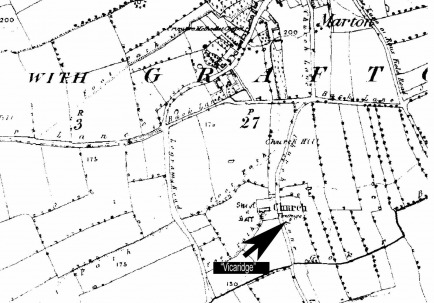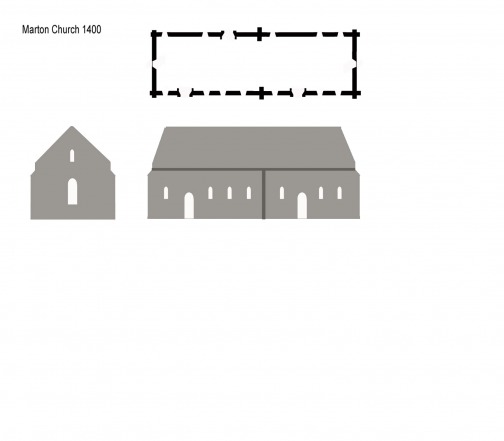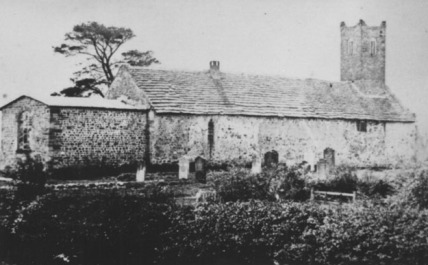The History Of Marton Church
The original Marton church is stated as Saxon. There is no evidence for the structure of physical appearance of the church, although a small handful os Saxon Churches do still exist in England.
There is no reason to assume that the Saxon Church was the original structure on the site. It is not at all unusual for early churches to be built over the site of even earlier places of worship, weather Christian or Pagan.
There is clear evidence for occupation in the area over many centuries, and each succeeding culture would have established its own centre of devotion and worship. It appears that the early church leaders saw the demolition of older temples and supplanting them with Christian Churches as a way of surplanting and oppressing the old beliefs and replacing them with the new.
In a vllage such as Marton the bulding of a church would have been undertaken at the Local Lords expense rather than by the Church as an organisation. The Lord would have also paid the living of the Priest and provided him with a house (which in the medieval period would not have been called "the vicarage" but simply "the Priests House")
The ordanance survey map if 1855 puts the word "Vicarage" opposite the churchyard. This could indicate the site of the original, Norman or earlier, priests house. We know that by 1855 the Vicarage proper was located elsewhere in Marton.
Vicarage
The Vicarage is sited on the 1855 maps to the east of Legram Lane by the old church site, and there is speculation that a remnant of wall in the hedgerow there could have been part of it. The following extract of the 1855 map shows the Vicarage and the Site of the Hall, as well as old footpaths in the direction of the Carr area.
Hargrove (3) states, “The vicarage was first appropriated to the priory of Monkton. In 1292 it was reported as worth £13.6s.8d.”
Saxon Church
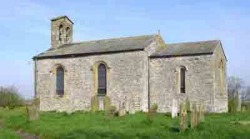
No hard structural evidence exists, although isolated fragments make it clear that a Saxon church stood on the site. Probably associated with the original manor house which, according to the Domesday Survey was held by a Gospatric. He is reported as having a Manor here, presumably in the field nearby called Hall Garth.
11th - 12th Century.

The Norman period saw the "Harrowing of the North" and the utter destruction of huge areas of Yorkshire.
The recovery from this led to the movement of the Village of Marton to its present location.
The Church was a small, crudely built structure 48ft 9In by 15ft 6in. The arch to the nave was exceptionally narrow at just over 3ft, due to the very thick walls. (Perhaps in an attempt to keep the Normans out!).
Sadly the thached roof would have negated any benefit the 5ft thick walls could have offered!
1200 - First Pointed Period

The Church was enlarged to the East (apparantly the westward direction was blocked by the Hall - (See "The Search for Marton's Medieval Hall")..
The dimentions are now externally 96 ft , being made up of the chancel at 39ft, the nave 57ft. This gave an internal dimention of 91ft, thus the East plus the West walls were a total of 6ft thick.
The Norman chancel arch was destroyed in the process. The church was not widened as the North and South walls were considered to be in too good a condition (or too thick and therefore too much work to move!)
14th Century

The Scottish incursion: The Scotss invaded in 1318 and camped at Myton, only a stones trow across the river from Marton.
They burnt a large number of villages until the citizens of York felt compelled to try to remove them. The subsequent slaughter is well recorded as the Battle Of Myton.
Marton and Grafton were both recorded as being raized by the Scots, and the Lunn recorded that evidence for buring was clear too see whern he finished what the Scots had started in 1875 and demolished the church.
He recorded that the Scots burnt the nave, but it was rebuilt soon after.
The sketch above is copied from Lunns own notes, and is his interpretation of the church in 1400, 80 years after the Scottish incursion.
16th Century

The church was rebuilt after being in a ruinous state for 60 years. Nave now only 73 feet in length.
1700 - 1730
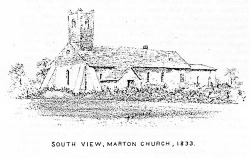
The resumption of the Chancel and the addition of the tower. The church would now look as the above sketch, again taken from Lunn's notes.
The Church would now remain pretty much the same until 1875 when it was demolished annd rebuilt on the curent site.
The Photograph below is the only known one, and was obviously taken before 1875.
In support of this history, the Yorkshire Herald Supplement quotes the following”.
In the process of demolition of the old church a number of voussoirs (wedge shaped sections of an arch) carved with chevrons and others with cable mounting were found in the filling up of the west wall (these are now in the arch to the Vestry in Christ Church). This proved the existence of a Norman church. Marks of the fire were discovered which tallied with the Scottish irruption in 1318, after which the rebuilding of the nave became necessary.
When a small nondescript window was pulled to pieces it was found to be the semi-circular head of a very small Norman window. In addition, fragraments of other Norman work were discovered which must evidently have been the Norman chancel arch. This arch was very narrow, being only 3 feet wide. All this Norman work was of grit-stone probably from lingerfield quarry”. In addition the article refers to sepulchral remains, one of which was inscribed with the date 1250.
In relation to the “Dissolution” during the Reformation the article states “ Marton Church appears to have been repaired and done up somewhere around 1600, possibly with materials obtained from the Hall which stood in what is now known as Hall Garth”.
Hargrove in the 7th edition of his book States “the Church is a vicarage, in the deanery of Boroughbridge, and diocese of Chester. Value in the king’s books, £2. 19s 4d (not dated but probably 18th C). Patron, St. John’s College, Cambridge.
He also states in the 1809 ed “some traces of the foundations of a large pile of buildings, may yet be seen, in a place called “Hall-Garth”, near the church.”
A well known local Historian, William Grainge, has written on Marton cum Grafton, and although the originals have not been seen yet,
Transcriptions by Margaret Power written in 2003 entitled Marton cum Grafton Civil History, Historical Retrospect and Physical History are available for reading but not copying.
An extract from the former of these is as follows: “Original church probably built by anglo-Normanic hands. Material from which it was built was of the rudest kind – pebbles from the gravel hills.
